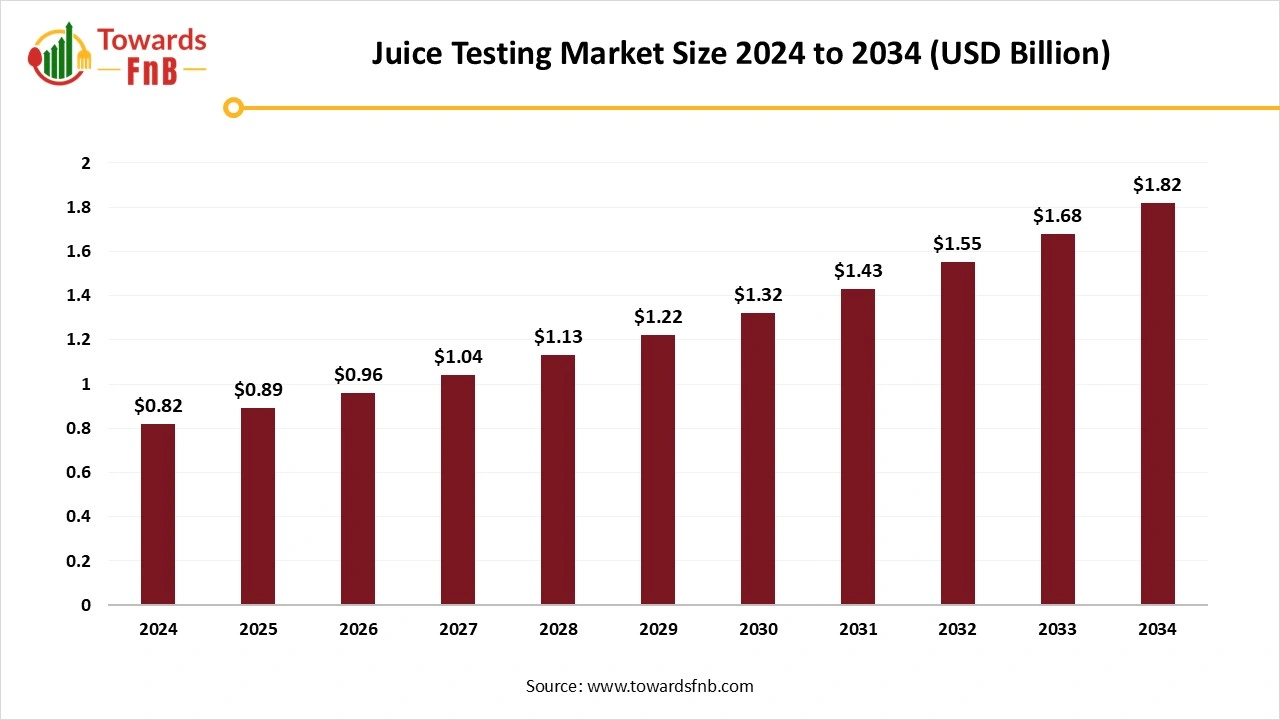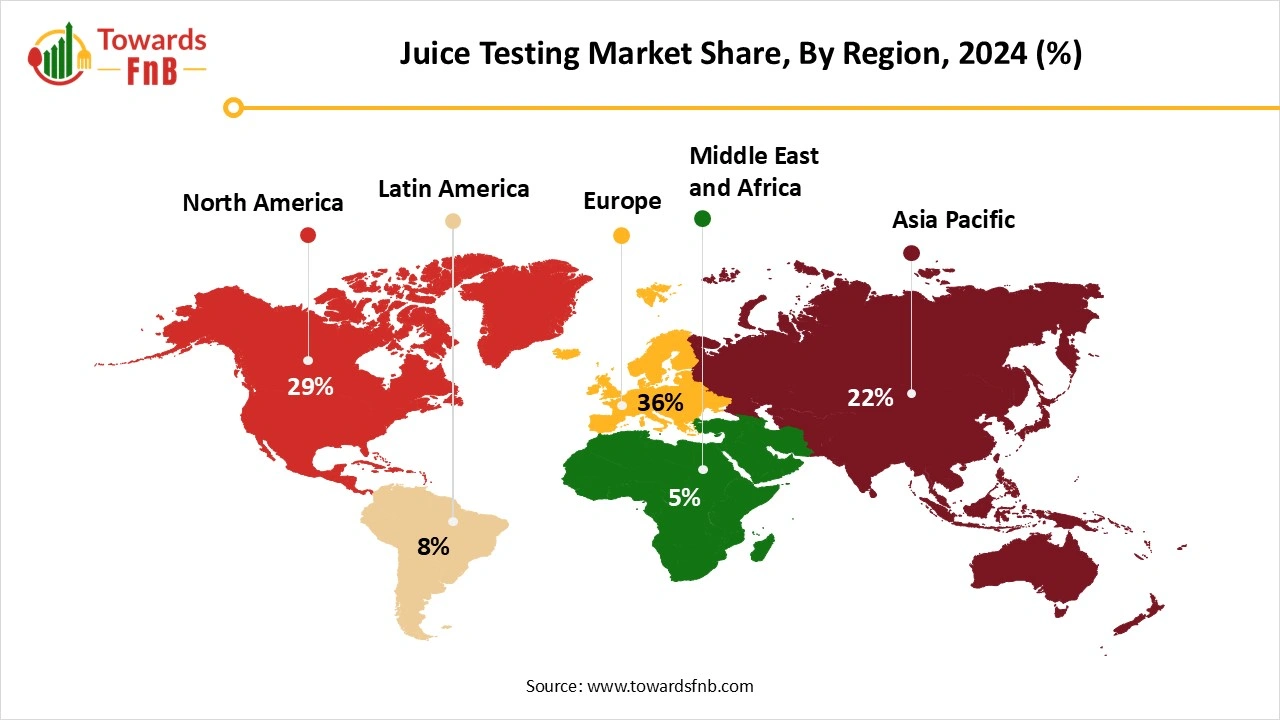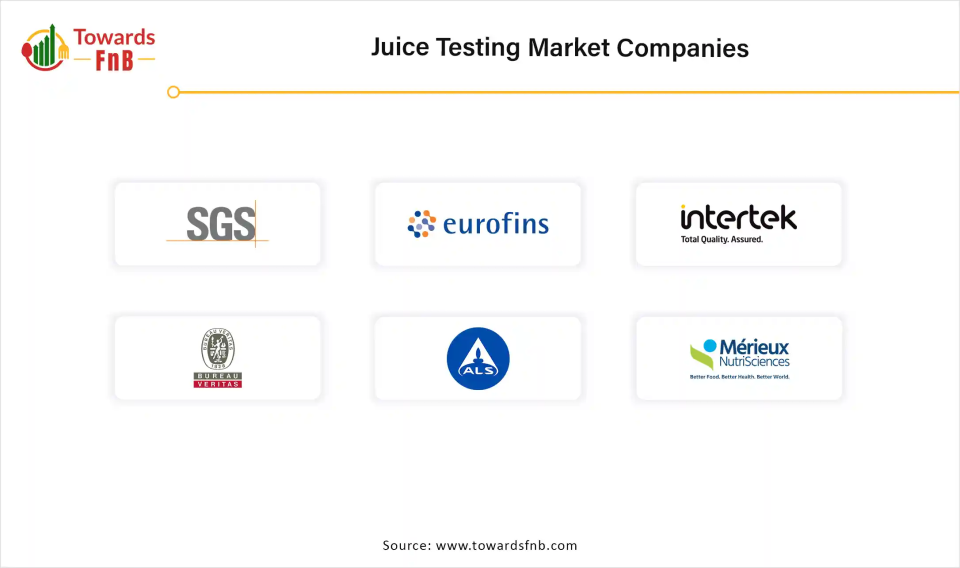October 2025
The global juice testing market size was reached at USD 0.82 billion in 2024 and is anticipated to increase from USD 0.89 billion in 2025 to an estimated USD 1.82 billion by 2034, witnessing a CAGR of 8.3% during the forecast period from 2025 to 2034. The increasing consumer preference towards organic, natural and preservative-free juices, which may enhance nutritional value and improve consumer satisfaction that may accelerate the market expansion.

| Study Coverage | Details |
| Growth Rate from 2025 to 2034 | CAGR of 8.3% |
| Market Size in 2025 | USD 0.89 Billion |
| Market Size in 2026 | USD 0.96 Billion |
| Market Size by 2034 | USD 1.82 Billion |
| Largest Market | Europe |
| Base Year | 2024 |
| Forecast Period | 2025 to 2034 |
| Regions Covered | North America, Europe, Asia-Pacific, Latin America, and Middle East & Africa |
The juice testing market involves the testing of fruit and vegetables juices for quality, safety, authenticity, nutritional content, and regulatory compliance. Juice testing ensures products meet standards for microbiological safety, pesticide residues, sugar and acid content, preservatives, and labelling accuracy. It is critical for juice manufacturers, exporters, bottlers, and regulators to verify purity, prevent adulteration, and maintain consumer trust. Demand is rising due to stricter food safety laws, growing exports, clean-label trends, and heightened consumer scrutiny over nutritional claims and contaminants.
Some of the major significant factors driving the growth of the market are ensuring quality and safety, compliance with standards, improving quality and taste, verifying nutritional content and determining shelf life. The juice quality testing helps in confirming compliance with the local international and required quality specifications and standards such as caffeine, acidity, and sugar content. Various companies can improve the condition of clean drinking water and the taste of the juices. In addition, Eurofins plays an important role in the juice testing, helping manufacturers to maintain consumer trust, ensure quality and meet safety standards, which are expected to fuel the growth of the market.
The rapid integration of robotics and artificial intelligence can revolutionize market growth. Automation plays an important role in an industry where high demand and strict profit margins make precision and speed essential. In the food and beverage, around 26% packaging lines have integrated robotics into their workflows in recent times. Robots are also improving workplace safety and helping address labor shortages. Human workers can focus on higher-level decision-making and supervision without spending hours on repetitive tasks.
This trend is expected to continue as more beverage manufacturers and breweries adopt robotics and AI, enhancing further advancements in quality control, safety and efficiency. In addition, robotics plays a crucial role in packaging, labeling and bottling. Robots are utilized to fill empty bottles onto unload filled bottles and filling lines. These advanced factors are expected to revolutionize the growth of the juice testing market in the coming years.
The quality of packaged fruit juice is impacted during their storage, packaging and processing that may cause deteriorative physical, chemical and biological alterations. Consumption of spoiled juices, either from non-biological or biological sources can create major challenges for the consumers. Reliable and sensitive methods are needed to ensure quality beverages. In addition, limited access to testing labs in developing regions and remote and high cost related to advanced lab infrastructure and testing equipment, which is further expected to restrain the growth of the juice testing market.
How Europe Dominates the Market Revenue in 2024?
Europe dominated the juice testing market revenue in 2024. The market growth in the region is attributed to the rising advanced chemical and microbial testing, increasing prevalence of contamination, increasing demand for consumer quality assurance, increasing food safety regulations, increasing consumer health awareness, and rising technological advancements in testing. Germany, France and UK are dominating countries driving the market growth in the region.

Germany dominated the market revenue in 2024, driven by increasing focus on sustainability, increasing presence of global testing companies, increasing demand for functional and clean-label juices, rising adoption of advanced testing technologies and increasing strict government regulations of food safety. People are rapidly consuming fruit nectars and fruit juices in Germany. At 6.8 liters per capita, orange juices are gaining popularity in Germany with apple juice in second rank at 5.1 liters.
Asia Pacific Juice Testing Market Trends
Asia Pacific is expected to grow fastest during the forecast period. The market growth in the region is attributed to the increasing demand for packaged juices, increasing consumer health awareness, growing rapid urbanization, increasing disposable incomes and increasing demand for functional and organic juices. China, India, Japan and South Korea are the fastest growing countries in the region.
India is expected to grow fastest during the forecast period. The market growth in India is attributed to the factors such as increasing consumer awareness towards health, increasing demand for clean-label and organic beverages, growing fruit production and increasing busy lifestyles and increasing focus on food quality and safety. India is popular for fresh fruits. Due to the freshly prepared and cheaper fruits, nearly 95% of the consumers purchase fresh fruits and fresh fruit juice in India, which may expect to increase the demand for juice testing in India.
Why did the Microbiological Testing Segment Held the Largest Juice Testing Market Revenue in 2024?
The microbiological testing segment dominated the juice testing market revenue in 2024. The microbiological testing play an important role in preventing and identifying contamination by toxic microorganisms, which may impact consumer safety, shelf life and product integrity. Producers can safeguard against spoilage organisms such as molds, yeasts and bacteria and ensure quality and safety of beverages by integrating robust microbiological testing. Effective microbiological testing makes sure that contaminants protecting both the brand and the product and are detected early. In addition, microbiological monitoring becomes essential to manage potential health risk and emerging spoilage microbes, with the reduction in thermal preservatives and processing in juice testing, which further expected to drive the segment growth in the market.
The Adulteration & Authenticity Testing Segment is Expected to Grow Fastest During the Forecast Period.
Adulteration & authenticity testing plays an important role in maintaining the integrity of beverages, fair trade and ensuring consumer safety. It helps to identify fraudulent practices, including mislabeling or adding cheaper ingredients, which can damage the reputation of juice manufacturers and harm consumers. In addition, there are various health benefits related to adulteration and authenticity testing such as consumer protection, economic motivated adulteration, maintaining product integrity, regulatory compliance, and protecting brand reputation, which further drives the segment growth.
What Factors Help Chromatography Segment Grow in 2024?
The chromatography segment dominated the juice testing market revenue in 2024. Chromatography plays an important role in ensuring the authenticity, quality and safety of fruit juices. This analytical technique enables complex mixtures for quantification and identification and separates them into individual components. In addition, due to environmental processing and factors, chromatography can measure and identify harmful substances and heavy metals that may contaminate juices. Chromatography ensures compliance with safe and legal limits and helps to detect food colorants, preservatives and additives. Furthermore, there are also other significance of chromatography such as analyzing nutritional quality, ensuring quality control and flavor consistency, detecting juice adulteration and supporting the integrity of the beverage industry, further accelerates the segment demand in the market.
The PCR & DNA-Based Methods Segment Expects the Fastest Growth During the Forecast Period.
The segment growth in the global juice testing market is attributed to preventing adulteration and ensuring authenticity, ensuring safety and quality, and increasing consumer health awareness. In addition, the PCR and DNA-based methods play an important role in comprehensive juice testing. Over the traditional approaches, they are enabling for identification of adulteration, pathogen detection and proper ingredient verification and provide significant benefits in terms reliability, speed and accuracy. These techniques evolve the food and beverage labeling regulations and are vital for ensuring the authenticity, safety and quality of juices, which is further expected to drive the segment growth in the global market.
How Fruit Juices Segment Dominates the Juice Testing Market Revenue in 2024?
The fruit juices segment dominated the juice testing market revenue in 2024. Fruit juices are widely made from a variety of fruits, such as pineapples, bayberries, tomatoes, grapefruit, cranberries, grapes, apples and oranges. Testing verifies compliance with regulations, detects adulteration and ensures nutritional value. Specific parameters such as contaminants, acidity and sugar content are routinely checked. In addition, there are various health related benefits of fruit juices such as advanced testing techniques, sensory evaluation and quality control, regulatory and safety compliance, detecting adulteration and enhanced nutritional value, which further expected to drive the segment growth in the global market.
The Cold-Pressed Juices Segment is Expected to Grow Fastest During the Forecast Period.
The segment growth in the market is attributed to the factors such as enhance nutritional profile, enhance taste and flavor preservation, reduced oxidation, accurate enzyme analysis, rising standardization, no-added sugar and higher yield. In addition, due to cold-pressed juice has minimal oxidation and nutrient retention, they offer various benefits. They provide a proper presentation of the nutritional flavor and content of the vegetables and fruits used.
Why did Juice Manufacturers & Bottlers Segment Held the Largest Juice Testing Market Revenue in 2024?
The juice manufacturers segment dominated the juice testing market revenue in 2024. The segment growth in the global market is driven by various key benefits such as scalability, access to resources, cost-effective, reduced risk, customization, faster time-to-market, improved consistency and quality and economies of scale. In addition, the ability to scale production down or up as required, without having to make major investments in personnel, facilities and equipment is one of the major benefits of juice manufacturers. To ensure that all products manufactured address the high demand of regulatory compliance, quality and safety, juice manufacturers have quality control and expertise in place. Furthermore, juice manufacturers help to reduce the risk related to production, such as regulatory non-compliance or product recalls. This can help small businesses focus on increasing their brand and reduce risk, which further fuels the segment demand.
The Regulatory Bodies Segment is Expected to Grow Fastest During the Forecast Period.
The segment growth in the market is driven by various factors such as increasing industry reputation and consumer trust, promoting market access and fair competition, maintaining product authenticity and quality and ensuring consumer safety. The regulatory bodies such as food standards and safety play an important role in promoting fair trade practices and improving public health in the juice market. In addition, regulatory bodies develop maximum significant limits for pathogens, molds, yeast and bacteria in fruit juices. These factors are expected to drive the growth of the juice testing market.
Organic retailer Erewhon
iSqueeze

By Test Type
By Technology
By Sample Type
By End-User
By Region
October 2025
October 2025
October 2025
October 2025